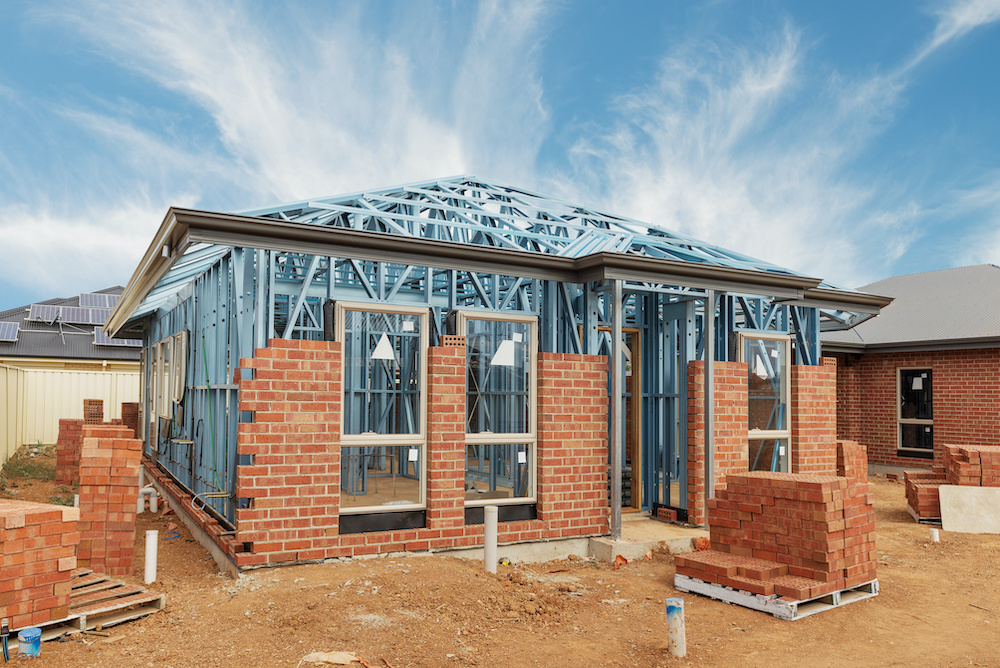For years, commercial builders have used steel to build hospitals, schools, skyscrapers, high-rise apartments and other large structures. Increasingly, steel framing is appearing in remodeling and new residential construction, and with good reason. Steel's environmental qualities and affordability make this technology worth a look.
Galvanized steel stud and floor joist systems resist rust, rot and termites. Steel will not warp, twist or split. It eliminates time-consuming culling, and it's 30 to 50 percent lighter than wood. Steel's stable nature yields straighter walls and level floors with little or no waste using wood-sized standard or custom-length studs and joists.
Steel framing allows for more design options than do traditional materials, including larger open spaces, arched ceilings and doorways, higher ceilings and longer spans. With steel, non-load-bearing walls can be altered or rearranged easily without affecting the structure. The stronger connections of lightweight steel make it a good choice for durable framing.
Costs and savings with steel framing
The current energy-related volatility of the market aside, steel prices have remained consistent for approximately 20 years, making project costs generally more predictable than with wood. Don Moody, president of Nuconsteel, one of the largest manufacturers of steel framing, maintains that steel's generally stable price offers remodelers greater cost control and therefore more accurate price quotes for clients.
Last year, PATH joined the Philadelphia chapter of Habitat for Humanity for a gut rehabilitation project in a South Philadelphia row house to show the advantages of residential steel framing. Steel was used for the interior framing - the load-bearing walls being the side party walls.
In Habitat's case, "steel framing was an affordable alternative to wood," says Bambi Tran, project manager for Steven Winter Associates, the project contractor. "In Philadelphia, steel is, piece by piece, price-comparable with wood," says Tran, although costs depend on the area.
On a gut rehab of a row house in Newburgh, N.Y., managed by SWA for the Department of Energy's Building America program, Habitat saved from $100 to $500 by using steel in conjunction with advanced framing techniques.
Factors in costs and savings of steel framing
However, residential steel framing can cost more than conventional wood framing until construction crews become familiar with different techniques. "Steel framing is great once you get past the learning curve," Tran says. "Rather than using nails, hammers and saws, carpenters need to use screws, screw guns and snips."
Adjusting to the different tools, equipment and installation techniques takes time. "So if it's your first house, you can expect to pay about 15 to 20 percent more," says Nader Elhajj, a researcher at the NAHB Research Center. "But cost becomes a non-issue once you get over the learning curve. The cost also depends on the component you are using. Roofs and exterior walls cost more, and interior walls and floors cost less."
Climate also can affect cost. In cold climates, contractors must install exterior insulating sheathing or another type of thermal break between the steel framing members and exterior walls. Without this break, thermal bridging of heat flow directly through the studs can lead to condensation on the steel members, stimulating mold growth, deteriorating the insulation and decreasing energy efficiency.
But steel studs in interior walls can cost $2 less per stud than wood, and steel floor joists usually cost less than dimensional wood products. Installation is also less expensive in these applications.
"Steel framing is becoming more accepted among nonprofit housing developers and builders because of price, availability and ease of installation on residential projects," Tran says. The same advantages can serve remodelers, whether the draw is price or the material's stability.
For more reports and answers about steel framing - including combination steel and wood framing - visit the PATH Web site at www.pathnet.org and PATH's site for technical information on building products, www.toolbase.org. To obtain the training manual Residential Steel Framing: National Training Curriculum, contact the Steel Framing Alliance at 202/785-2022 or order it online at www.steelframingalliance.com.
Kia McLeod and Susan Conbere are with the energy and environmental consulting firm D&R International in Silver Spring, Md. The Partnership for Advancing Technology in Housing is a public-private partnership dedicated to increasing the development and adoption of advanced building technologies.
Steel Vs. Wood: A Time and Cost Analysis
In 2001, PATH conducted a field evaluation in Sturgeon, Mo., using insulated concrete forms and cold-formed steel for the structural floor and roof assemblies.
Following MADE (marketable, affordable, durable, entry-level) design principles, Hopke Buildings and Grounds reconstructed a house that had been gutted by fire in 1999. On PATH's behalf, the NAHB Research Center tracked the labor hours spent to install the first-floor assembly and the process of securing the perimeter rim track to the concrete wall forms. The research team compared building the steel assembly to building a similar engineered-wood, I-joist floor system at another site.
Labor: Assembling the steel joists and subflooring required 61 percent more labor than the wood project, based on labor minutes per square foot. Cutting and fastening took almost twice as long on the steel project, and positioning took one-third more time.
Materials: Compared with the wood project, the steel project saved 26 percent in floor assembly materials costs on a square-foot basis - enough to offset the greater labor requirements for the steel project.
Contractors using steel for the first time should experiment with fasteners and equipment before beginning an installation. As workers become more familiar with steel framing techniques, the time spent adjusting equipment or reworking a job likely will become insignificant within three to five houses.
To read more on this project, see the Field Evaluations section of the PATH Web site (www.pathnet.org) under Activities.



